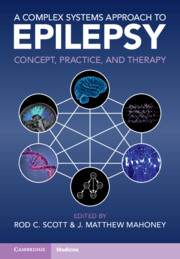Book contents
- A Complex Systems Approach to Epilepsy
- A Complex Systems Approach to Epilepsy
- Copyright page
- Contents
- Contributors
- Chapter 1 Introduction
- Chapter 2 Systems Biology Approaches to the Genetic Complexity of Epilepsy
- Chapter 3 Transcriptomic and Epigenomic Approaches for Epilepsy
- Chapter 4 Phenomenological Mesoscopic Models for Seizure Activity
- Chapter 5 Personalized Network Modeling in Epilepsy
- Chapter 6 The Baseline and Epileptiform EEG
- Chapter 7 Neuronal Approaches to Epilepsy
- Chapter 8 Mapping Epileptic Networks with Scalp and Invasive EEG
- Chapter 9 A Neuroimaging Network-Level Approach to Drug-Resistant Epilepsy
- Chapter 10 Epilepsy as a Complex Network Disorder
- Index
- References
Chapter 3 - Transcriptomic and Epigenomic Approaches for Epilepsy
Published online by Cambridge University Press: 06 January 2023
- A Complex Systems Approach to Epilepsy
- A Complex Systems Approach to Epilepsy
- Copyright page
- Contents
- Contributors
- Chapter 1 Introduction
- Chapter 2 Systems Biology Approaches to the Genetic Complexity of Epilepsy
- Chapter 3 Transcriptomic and Epigenomic Approaches for Epilepsy
- Chapter 4 Phenomenological Mesoscopic Models for Seizure Activity
- Chapter 5 Personalized Network Modeling in Epilepsy
- Chapter 6 The Baseline and Epileptiform EEG
- Chapter 7 Neuronal Approaches to Epilepsy
- Chapter 8 Mapping Epileptic Networks with Scalp and Invasive EEG
- Chapter 9 A Neuroimaging Network-Level Approach to Drug-Resistant Epilepsy
- Chapter 10 Epilepsy as a Complex Network Disorder
- Index
- References
Summary
In the mid-1980s a number of scientists and research bodies conceived the idea of determining the DNA sequence of the entire human genome. Initiated in 1990 and known as the Human Genome Project (HGP), this ambitious, publicly funded project relied on contributions from numerous international laboratories and remains the world’s largest collaborative biological-based project to date. The completion of the HGP thirteen years later in 2003 allowed scientists to view the human genome in its entirety for the first time [1]. It was thought that this would usher in a new age for biological research, allowing for a more comprehensive understanding of complex human diseases and phenotypes. While this was true to an extent, completion of this project led to a series of new, more complicated questions, as is often the case in research.
- Type
- Chapter
- Information
- A Complex Systems Approach to EpilepsyConcept, Practice, and Therapy, pp. 19 - 40Publisher: Cambridge University PressPrint publication year: 2023



